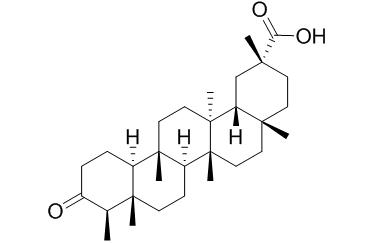Polpunonic acid
Polpunonic acid is a natural product from Tripterygium wilfordii Hook.f.
Inquire / Order:
manager@chemfaces.com
Technical Inquiries:
service@chemfaces.com
Tel:
+86-27-84237783
Fax:
+86-27-84254680
Address:
1 Building, No. 83, CheCheng Rd., Wuhan Economic and Technological Development Zone, Wuhan, Hubei 430056, PRC
Providing storage is as stated on the product vial and the vial is kept tightly sealed, the product can be stored for up to
24 months(2-8C).
Wherever possible, you should prepare and use solutions on the same day. However, if you need to make up stock solutions in advance, we recommend that you store the solution as aliquots in tightly sealed vials at -20C. Generally, these will be useable for up to two weeks. Before use, and prior to opening the vial we recommend that you allow your product to equilibrate to room temperature for at least 1 hour.
Need more advice on solubility, usage and handling? Please email to: service@chemfaces.com
The packaging of the product may have turned upside down during transportation, resulting in the natural compounds adhering to the neck or cap of the vial. take the vial out of its packaging and gently shake to let the compounds fall to the bottom of the vial. for liquid products, centrifuge at 200-500 RPM to gather the liquid at the bottom of the vial. try to avoid loss or contamination during handling.
Food Chem X.2024, 24:101794.
Evid Based Complement Alternat Med.2020, 2020:2584783.
QASCF2022, 14(4).
Applied Biological Chemistry2023, 66(58):112.
J Biomed Sci.2020, 27(1):60.
Phytomedicine.2019, 55:229-237
Sci Rep.2017, 7:467-479
J Cell Mol Med.2023, jcmm.17968.
Analytical sci. & Tech2016, 186-193
Antioxidants (Basel).2021, 10(8):1300.
Related and Featured Products
Canadian Journal of Chemistry, 1981, 59(17): 2677-2683.
Cytotoxic diterpenes triptolide, tripdiolide, and cytotoxic triterpenes from tissue cultures of Tripterygium wilfordii[Reference:
WebLink]
METHODS AND RESULTS:
Plant tissue cultures of Tripterygium wilfordii Hook F produced the cytotoxic diterpene triepoxides tripdiolide (1) and triptolide (2) in yields that were 16 and 3 times greater, respectively, than those observed in the plant itself. Other diterpenes, dehydroabietic acid (3) and 15-hydroxy-18-norabieta-3,8,11,13-tetraene-3-oic acid methyl ester (4) were also isolated. Co-occuring in these cultures were the cytotoxic quinone-methides, celastrol (5), compound 6, and compound 7. Other triterpenes produced were oleanolic acid (8) and Polpunonic acid (9). β-Sitosterol (17) was also isolated.
CONCLUSIONS:
The proposed structure of 4 was confirmed by synthesis starting from compound 3. Cytotoxic data are reported, and a possible biosynthetic relationship among dehydroabietic acid, compound 4, and tripdiolide (1) is presented.



